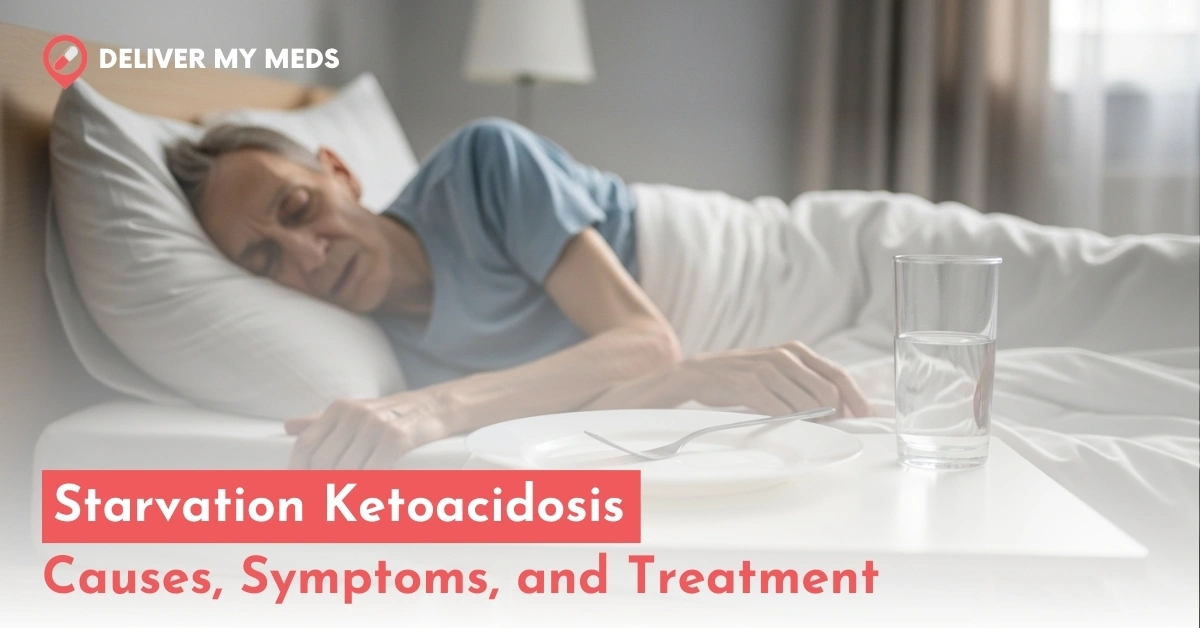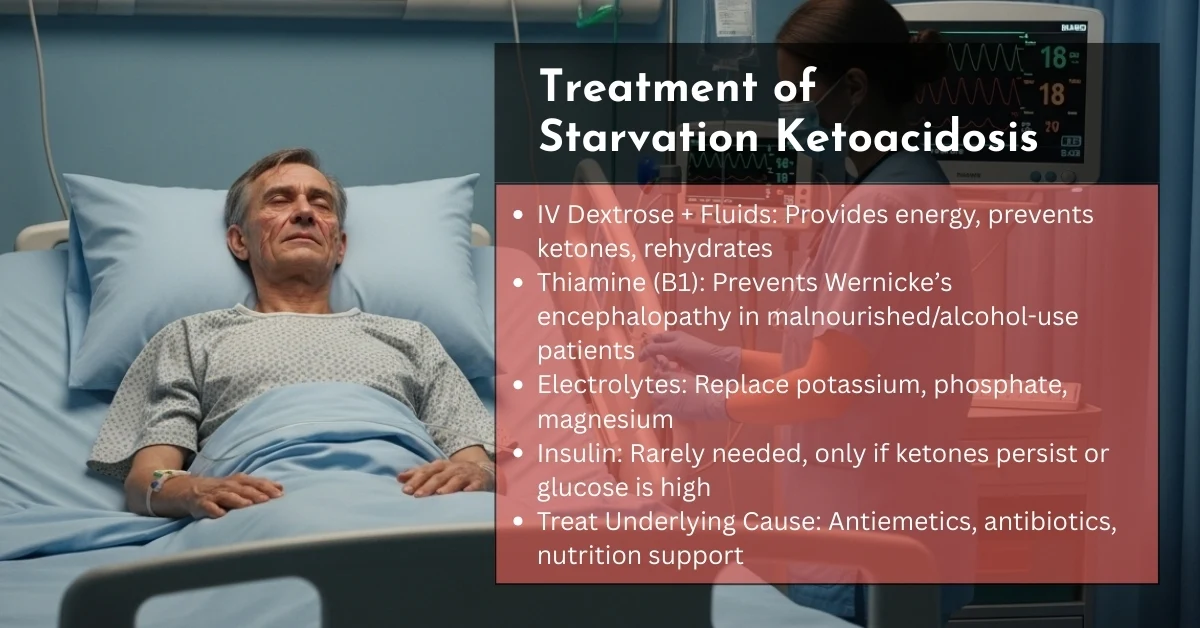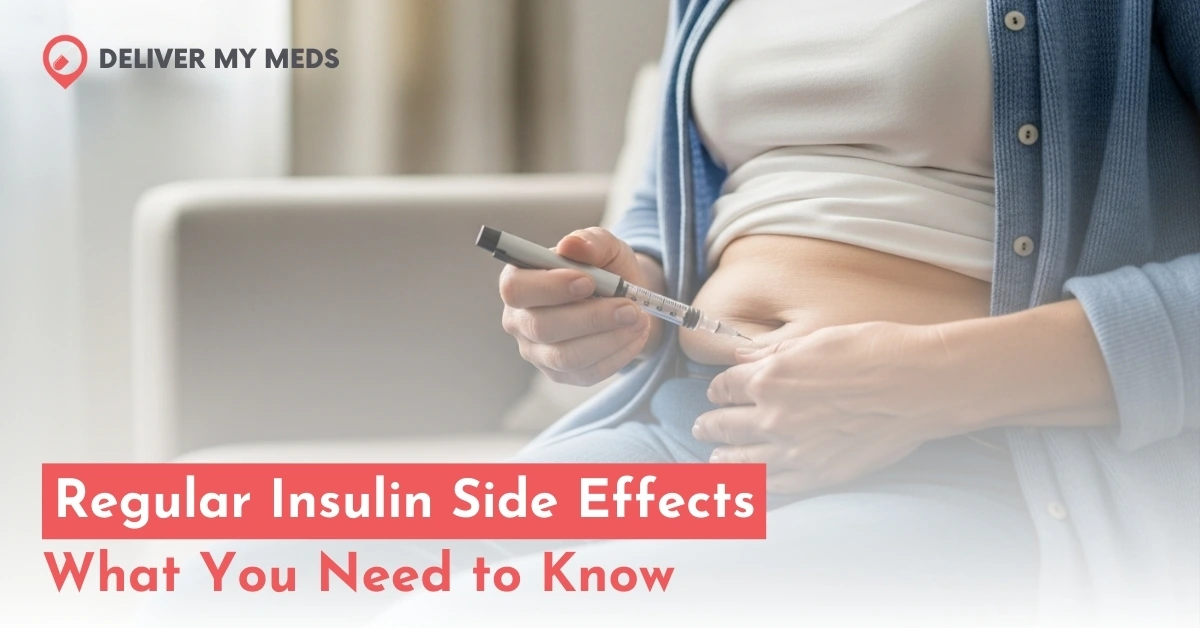
When you don’t eat for many days, your body starts to burn fat, which in turn reduces your glucose supply. Glucose is your primary fuel that is generated in the power house of the cell called mitochondria. This process releases acids called ketones. Typically, your body can always handle a small amount of ketones. But if they build too much, your body’s blood becomes dangerously acidic. And this condition is called starvation ketoacidosis. On the other hand, Diabetic Ketoacidosis usually happens when your blood sugar is very high. However, starvation ketoacidosis occurs when your sugar levels are low or normal.
In this blog, you can understand the symptoms, risk, and treatment of starvation ketoacidosis, as well as the difference between SKA and DKA, which is vital for you if you are at risk, such as eating disorders, pregnancy, or continuous vomiting. At Deliver My Meds (DMM), we understand that timely access to the proper treatment and preventive care can significantly reduce the risk of serious complications like SKA.
What is Starvation Ketoacidosis?
Starvation ketoacidosis occurs when your body runs out of energy. The main energy of your body is glucose, which comes from the food you eat in your daily life, especially from carbohydrates. When you don’t eat for many days, your body gets energy from different sources, like breaking down fat in your body. And the burning of these fats releases acids. The name of that acid is called ketone. A small amount of ketones present in the body is normal, but if the amount of ketones is too much, it can make your blood acidic, and that is dangerous for you.
Think like this:
- Food gives your body glucose, which is fuel for your body.
- When you don’t eat food, your sugar levels drop from a normal point.
- The body burns the fat and converts it into energy.
- When your body burns too much fat, it makes extra ketones in your body
- The extra ketones make your body acidic, which can be dangerous.
Understand the Main Types of Ketoacidosis
The main types of ketoacidosis are given below:
1. Starvation Ketoacidosis (SKA)
This ketoacidosis presents when you don’t eat for a long time and forcing the body to burn fat of your own body for energy. Excess fat breakdown makes too many ketones. This raises acidity in the blood, which causes SKA.
2. Diabetic Ketoacidosis (DKA)
This ketoacidosis happens mostly in people with diabetes, especially in type 1 patients. In the deficiency of insulin, your sugar stays in the bloodstream without entering the cells. The body burns fat, causing very high ketones and a rise in blood sugar.
3. Alcoholic Ketoacidosis (AKA)
Seen in many people who are heavy drinkers and eat little or nothing. Alcohol and poor food can lower your glucose level and cause dehydration in your body. The body rapidly burns fat, leading to high ketones and acidic blood.
Why this matters: Each type of ketoacidosis needs a different treatment. If someone with this starvation ketoacidosis problem gets insulin instead of sugar, their blood sugar can drop to a very dangerous level. For people already living with diabetes, devices like the Dexcom G7 starter kit from DMM help track glucose levels and spot unusual changes early.
Starvation Ketoacidosis vs Diabetic Ketoacidosis:
In starvation ketoacidosis (SKA), your blood sugar is usually normal or low. In diabetic ketoacidosis (DKA), your blood sugar is usually high. SKA happens if you don’t eat for many days, vomit a lot, are pregnant, or are sick. Diabetic ketoacidosis (DKA) occurs when there is insufficient insulin in the body, which can result from missed insulin doses, infections, or the use of certain diabetes medications.
Both make too many ketones and acid in your blood, but the treatments are different:
- SKA: give sugar (dextrose) and fluids, sometimes vitamin B1
- DKA: give insulin, fluids, and electrolytes
Giving insulin by mistake in SKA can make your blood sugar too low. Missing DKA can delay important treatment.
Quick Table:
| Feature | Starvation Ketoacidosis (SKA) | Diabetic Ketoacidosis (DKA) |
| Glucose | Normal or low | High (often >250 mg/dL) |
| Trigger | Fasting, vomiting, pregnancy, illness | Insulin deficiency, missed doses, infection, SGLT-2 use |
| Ketones | High | High |
| Acid in blood | High | High |
| First treatment | Dextrose + fluids, thiamine if needed | Insulin + fluids + electrolytes |
| Key risk | Misdiagnosed: hypoglycemia risk | Missed euglycemic DKA: delayed care |
Causes and Risk Factors of Starvation Ketoacidosis
Causes include:
- Prolonged fasting or very low-carb diets
- Eating disorders (anorexia)
- Severe vomiting (e.g., hyperemesis in pregnancy)
- Illnesses with poor intake (pancreatitis, infections)
- Alcohol use (overlap with alcoholic ketoacidosis)
Who’s at higher risk?
- Pregnant women (accelerated “starvation” response)
- People with eating disorders
- Those with heavy alcohol use
- People with diabetes on SGLT-2 inhibitors
Symptoms of Starvation Ketoacidosis
Symptoms can develop slowly but may worsen quickly. You might notice:
- You may feel nausea, vomiting, or stomach pain
- You may feel very tired, dizzy, or weak in your muscles
- You may start breathing fast or deeply
- Your breath may have a fruity smell (like acetone)
- You may get dry mouth or pass very little urine (a sign of dehydration)
In severe cases, the starvation ketoacidosis can cause serious problems like confusion, extreme tiredness or low blood pressure.
Warning: The starvation ketoacidosis symptoms are more likely to happen during pregnancy, in people with eating disorders, after several days of vomiting, or in diabetes patients taking SGLT-2 inhibitors (which can also trigger a type of ketoacidosis called euglycemic DKA).
Tips: Having a blood pressure monitor like the Omron 10 Series (available at DMM) at home can also help detect red flags such as dangerously low blood pressure in at-risk patients.
Starvation Ketoacidosis Labs & Diagnosis
Doctors diagnose SKA using blood and urine tests. Key lab features include:
| Test | Finding in Starvation Ketoacidosis |
| Blood glucose | Normal or low (unlike DKA, where it’s high) |
| Blood pH | Low (acidic) |
| Serum ketones | Elevated |
| Bicarbonate | Low |
| Anion gap | Increased |
Important: If glucose is high, HbA1c or antibody tests can help show whether this is new diabetes with DKA or just stress-related sugar with SKA. Patients with diabetes who use the FreeStyle Libre 3 plus sensor from DMM can easily identify changes in their blood sugar.
Treatment of Starvation Ketoacidosis
The primary objective is to prevent ketone development and address dehydration.
- IV dextrose (sugar water) and fluids: It gives your body quick energy and stops the production of ketones in the body, also prevents dehydration, and helps to flush ketones.
- Thiamine (vitamin B1): Particularly in patients with alcohol use disorders or malnutrition, to avoid Wernicke’s encephalopathy.
- Electrolyte Replacement: May involve the addition of potassium, phosphate, and magnesium.
- Insulin: It is usually not needed unless ketones don’t fall, glucose is high, or DKA is suspected.
- Treat the Cause: Antiemetics for vomiting, antibiotics for infection, and nutrition support.
Most patients improve within 12-24 hours once treatment starts.
Complications of SKA:
- Severe acidosis may lead to low blood pressure, arrhythmias, and confusion.
- Electrolyte drops may lead to weakness or heart rhythm problems.
- Giving insulin too early without dextrose will result in hypoglycemia.
- Missing euglycemic DKA in diabetes patients delays proper treatment.
Prevention Tips by Deliver My Meds
- Avoid going hungry for too long, and also don’t follow a low-carb diet without consulting your doctor.
- If you are sick and vomiting, it’s best to drink fluids with some sugar, as this will help you recover more quickly.
- Pregnant women should address nausea promptly; talk to their health provider before fasting.
- People with diabetes on SGLT-2 medicines: If you’re sick or can’t eat, stop your SGLT-2 medicine and check your ketones.
Warning: Starvation ketoacidosis is rare but serious. If you notice fast breathing, confusion, or fruity-smelling breath, seek medical help immediately.
Conclusion
Starvation ketoacidosis is dangerous if you don’t treat it quickly. It may occur when you don’t eat for a long time, such as during extended fasting or periods of very low food intake. Certain factors can raise ketone levels in the blood, which in turn acidify the blood. Unlike diabetic ketoacidosis, initial treatment involves sugar (dextrose), fluids, electrolytes, and possibly vitamin B1 (thiamine), rather than insulin. Awareness of the signs, laboratory findings, and high-risk patients enables early treatment for both patients and doctors. Basic precautions, such as preventing prolonged fasting, correcting vomiting early, and monitoring ketone levels in at-risk patients, can help prevent complications.



